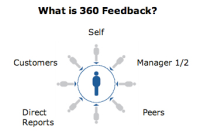The 360 Degree Performance Evaluation
Updated January 2, 2015 by Matt H. Evans

Every published report recommends multiple as opposed to single raters for performance appraisal. – John Bernardin, Author & Expert on Performance Appraisal
When you tap into an employee's circle of influence, you will have a major impact on changing employee behavior. Additionally, employees often respect the feedback of co-workers more than their respective supervisor. A survey of Coca-Cola Foundation employees indicates that over 90% of employees prefer evaluations that include both co-worker and supervisor. Only 4% of employees chose to have their performance evaluations performed by the supervisor only.
Surveys are often used for collecting the feedback used to evaluate the employee. It is very important to keep surveys short and to the point. A few open comment questions can be included. However, you need an objective way of scoring the surveys. It is also important to maintain anonymity; i.e. receivers of the surveys should not know who provided the information. Likewise, the information received must be controlled so that confidentiality is maintained.
Example of Survey Questions for Evaluating Employee Performance :
Assign a score of 1 to 10 for each of the following questions. 1 is the lowest score (strongly disagree) and 10 is the highest score (strongly agree). N for Don't Know
1. Performs day to day activities in a timely and accurate manner. ____
2. Communicates effectively, both orally and in writing ____
3. Demonstrates initiative for solving problems ____
4. Directs and leads others in a positive way ____
5. Coordinates and manages time, people and other resources well ____
As with any new approach to managing people, the 360-degree approach requires careful planning. For example, training is a must since employees will be apprehensive about how this new evaluation approach will work. Training should address fundamental questions, such as what is the 360 approach, why is the organization adopting it, who will be doing the evaluations, how will the information be collected, etc.
The design of a 360-feedback process should actively enlist the employee. The employee and the supervisor should jointly agree on the evaluation team, consisting of no more than six targets (co-worker, supervisor, customer, etc.). Design of the surveys for feedback is also important since traditional approaches will not fit:
Traditional Survey . . . . . . . . . . . . . . . . . . . . . . . 360 Feedback Survey
Single Target Audience . . . . . . . . . . . . . . . . . . . Numerous Targets (all employees)
Numerous Responses . . . . . . . . . . . . . . . . . . . . Few Responses (5 to 7) per target
Response Rates may be low . . . . . . . . . . . . . . . Need High Response Rate for Objectivity
Respondent may be known . . . . . . . . . . . . . . . . Respondents must be anonymous
Survey may be long . . . . . . . . . . . . . . . . . . . . . .Survey must be short (less than 20 minutes)
Distributed through traditional ways . . . . . . . . . . Electronic distribution is common
Control over surveys is low . . . . . . . . . . . . . . . . Control must be high for confidentiality
Consistent rules must be adopted to make sure the process is fair for all employees. For example, you will need rules on when to throw out invalid survey responses. Some companies consider a survey as invalid when the individual response is more than 50% different than all other responses. Minimum levels are also needed for acceptance of surveys. For example, a required response rate of 75% is common where employee compensation is linked to 360 feedback results.
This article has touched on some of the basics behind the 360-feedback process. Multi-source systems, such as the 360 feedback, are more objective, accurate, creditable, and influential than traditional single source systems. By tapping into sources closet to the employee, we can better motivate and manage the employee. And since employees are at the center of organizational performance, we need fair and accurate methods for evaluating employee performance. The 360-degree feedback model is one of the best methods for driving employee performance and satisfaction.
 Written by: Matt H. Evans, CPA, CMA, CFM | Email: matt@exinfm.com | Phone: 1-877-807-8756
Written by: Matt H. Evans, CPA, CMA, CFM | Email: matt@exinfm.com | Phone: 1-877-807-8756
Return to Listing of All Articles |
![]() | Mobile / Blog Friendly Version
| Mobile / Blog Friendly Version
